Pengaruh Campuran Perekat Terhadap Nilai Kalor Briket Arang Sabut Kelapa
Keywords:
Energi Alternatif, Briket, Biomassa, Nilai KalorAbstract
A Zero-Carbon World 2050 informs, empowers action and accelerates progress. Accelerating the progress of global priorities there are several points. The points in question include creating and maintaining a fair and resilient zero carbon economy, replacing fossil fuels with renewable alternative energy. Renewable alternative energy fueled by local potential that can be developed is biomass. Coconut coir is a biomass waste that is underutilized and can be used as biobriquettes. Cellulose is the main ingredient for making biobriquettes, the higher the cellulose content the better the quality of the biobriquettes. Biobriquettes have several factors, namely the material used, the fineness of the carbonization results, the carbonization temperature, the density of the charcoal, the density and pressure in the biobriquette molding process. The biobriquette molding process is a material manufacturing technique. For solid fuels, the process involves bonding together pulverized carbon materials, often with adhesives. The purpose of this study was to determine the quality of the calorific value of biobriquettes from coconut coir. The tests carried out were experiments on the quality of the calorific value of biobriquettes. Experimental testing of the calorific value is by using a bomb calorimeter. Where to test the calorific value of biobriquettes with a comparison of the adhesive percentage, namely 10%, 15%, 20%, 25% and 35%. The calorific values from the influence of the percentage of starch adhesive obtained were: 4293.45 : 4488.22 : 3942.88 : 3748.11 and 2969.05. It can be concluded that the calorific value of biobriquettes made from coco coir with starch adhesive according to this experiment is in accordance with the quality standards of biobriquettes, namely the percentage of 85%: 15% with a calorific value of 4488.22.
Keywords : Alternative Energy, Biobriquettes, Biomass, Calorific Value
Abstrak
Dunia Nol-Karbon 2050 ini menginformasikan, memperkuat tindakan, dan mempercepat kemajuan. Mempercepat kemajuan prioritas global ada beberapa point. Point yang dimaksud antara lain yaitu menciptakan dan mempertahankan ekonomi nol karbon yang adil dan tangguh, penggantian bahan bakar fosil dengan energi alternatif terbarukan. Energi alternatif terbarukan berbahan bakar potensi lokal yang dapat dikembangkan yaitu bioamassa. Sabut kelapa merupakan limbah biomassa yang kurang termanfaatkan dan bisa dijadikan sebagai briket. Selulosa merupakan bahan utama pembuatan briket, apabila nilai kandungan selulosa semakin tinggi maka semakin baik juga kualitas briket yang dihasilkan. Briket memiliki beberapa faktor yaitu bahan yang digunakan, kehalusan hasil karbonisasi, temperatur karbonisasi, massa jenis arang, kerapatan dan tekanan pada proses pencetakan briket. Proses pencetakan briket merupakan teknik pembuatan bahan bakar yang padat, prosesnya melibatkan pengikatan bersama bahan karbon yang di haluskan, seringkali dengan perekat. Tujuan dari penelitian ini adalah mengetahui kualitas nilai kalor briket dari sabut kelapa. Pengujian yang dilakukan yaitu eksperimen kualitas nilai kalor briket. Pengujian eksperimen nilai kalor (panas) yaitu menggunkan bomb calorimeter. Dimana perbandingan persentase perekat pada pengujian kalor pada briket ini yaitu 10%, 15%, 20%, 25%, dan 35%. Nilai kalor dari pengaruh persentase perekat kanji didaptakn yaitu : 4293,45 : 4488,22 : 3942,88 : 3748,11 dan 2969,05. Dapat disimpulkan nilai kalor briket berbahan sabut kelapa dengan perekat kanji sesuai eksperimen kali ini yang sesuai dengan standar mutu briket yaitu pada persentase 85% : 15% dengan nilai kalor 4488,22.
Keywords: Energi Alternatif, Briket, Biomassa, Nilai Kalor
Downloads
References
J. Wiseman, “The great energy transition of the 21st century: The 2050 Zero-Carbon World Oration,” Energy Res. Soc. Sci., vol. 35, no. March 2017, pp. 227–232, 2018, doi: 10.1016/j.erss.2017.10.011.
Hilmiati, L. Husraini, and A. Zamhuri, “Densification of Product Torrefaction from Coconut Coir to Bio-briquette as Renewable Energy that Environmentally,” Int. J. Environ. Res. Clean Energy, vol. 12, no. 1, pp. 13–16, 2018.
X. Zhu, Y. Li, and X. Wang, “Machine learning prediction of biochar yield and carbon contents in biochar based on biomass characteristics and pyrolysis conditions,” Bioresour. Technol., vol. 288, no. April, p. 121527, 2019, doi: 10.1016/j.biortech.2019.121527.
A. S. Noah, O. A. Okon-Akan, and J. K. Abiola, “Energy Characterisation of Briquettes Produced from Admixture of Arundo donax L . and Coconut Coir,” Am. Sci. Res. J. Eng. Technol. Sci., vol. 56, no. 1, pp. 136–151, 2019.
N. A. Rahman, M. Ajiza, D. A. Anggorowati, F. E. K. Rastini, and L. Mustiadi, “Clove leaf distillation using briquette fuel with starch and molasses as a binder,” Mater. Today Proc., vol. 63, pp. S293–S296, 2022, doi: 10.1016/j.matpr.2022.03.142.
H. Wahyuni, A. Aladin, R. Kalla, and M. Nouman, “Utilization of Industrial Flour Waste as Biobriquette Adhesive : Application on Pyrolysis Biobriquette Sawdust Red Teak Wood,” vol. 1, no. 2, pp. 54–69, 2022.
A. Sulistyanto, “Pengaruh Variasi Bahan Perekat Terhadap Laju Pembakaran Biobriket Campuran Batubara Dan Sabut Kelap,” Media Mesin Maj. Tek. Mesin, vol. 8, no. 2, pp. 45–52, 2017, doi: 10.23917/mesin.v8i2.3100.
B. Indrawijaya, “Briket Bahan Bakar Dari Ampas Teh Dengan Perekat Lem Kanji,” J. Ilm. Tek. Kim., vol. 3, no. 1, 2019, doi: 10.32493/jitk.v3i1.2597.
R. Moeksin, F. Aquariska, and H. Munthe, “POLIETILEN,” vol. 23, no. 3, pp. 173–182, 2017.
M. O. Okwu and O. D. Samuel, “Adapted hyacinth briquetting machine for mass production of briquettes,” Energy Sources, Part A Recover. Util. Environ. Eff., vol. 40, no. 23, pp. 2853–2866, 2018, doi: 10.1080/15567036.2018.1512681.
Wahyudi, “‘Penelitian Nilai Kalor Biomassa : Perbandingan Antara Hasil Pengujian dengan Hasil Hitungan,’” J. Ilm. Semesta Tek., vol. 9, no. 2, pp. 208–220, 2006.
Downloads
Published
Issue
Section
License
Copyright (c) 2023 Guntur Ofan Jabu

This work is licensed under a Creative Commons Attribution-NonCommercial 4.0 International License.




